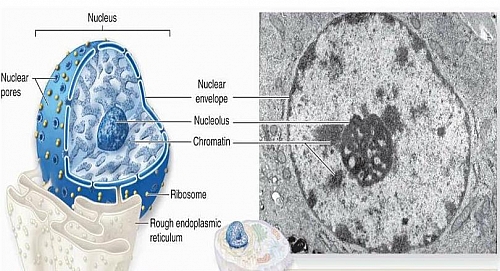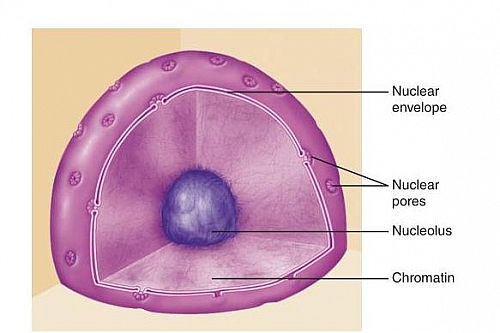Table of Contents
What is Nucleus?
The Nucleus is the largest organelle of cells that is involved in the control of the cell activities; it constitutes the central, more dense, part of the cell. It is usually rounded or ellipsoid. Occasionally it may be elongated, indented or lobed. It has a diameter of 10 to 22 and occupies about 10% of total volume of the cell.
The nucleus if bounded by a double layered membrane called the nuclear envelop or the nuclear membrane which bounds the nucleoplasm( a transparent and dense fluid that is bounded by the nuclear membrane); suspended in the nucleoplasm is the chromosomes and nucleolus.
Cells can have more than one nucleus or may lack a nucleus all together. The Skeletal muscle cells of the body contain more than one nucleus whereas matured red blood cells do not contain a nucleus at all. The nucleus is bounded by the nuclear envelope, a phospholipid bilayer similar to the plasma membrane. The space between these two layers is the Nucleolemma Cisterna.
The Nucleus houses the genetic material of the cell Deoxyribo Nuclei Acid (DNA), which carries the hereditary information in the cell. Normally the DNA is spread out within the nucleus as a threadlike matrix called Chromatin.
When the cell begins to divide, the chromatin condenses into rod-shaped bodies called Chromosomes, each of which, before dividing, is made up of two long DNA molecules and various histone molecules. The histones serve to organize the lengthy DNA, coiling it into bundles called nucleosomes. Also visible within the nucleus are one or more nucleoli, each consisting of DNA in the process of manufacturing the components of ribosomes.
Ribosomes are shipped to the cytoplasm where they assemble amino acids into proteins. The nucleus also serves as the site for the separation of the chromosomes during cell division.
Nucleus Definition
Nucleus: Singular (Nuclei: Plural) is the cell organelle that organizes and coordinates the functions of the cell. It can be seen as the central processing unit of the cell or the center for control of cellular activities. Robert Brown discovered the Nucleus and named it in 1831 AD in the cell of orchid leaf.
Most cells have a single nucleus that contains the genetic material of the cell called the DNA. The DNA exists as thin threads called Chromatin, except during cell division. The nucleus generally appears as a prominent spherical structure in the cell.
Do all cells have a Nucleus?
Not all types of cells have nuclei as Prokaryotic cells do not have nuclei. Some Eukaryotic cells do not have a nucleus such as sieve tube and matured Red blood cells (RBC) of the body.
Nucleus Location (Where is the Nucleus found?)
The Nucleus is located in the Protoplasm of the cell it is in the cytoplasm but has its own double layered membrane called the nuclear membrane inside which is a fluid like that of the cytoplasm called Nucleoplasm. The nucleolus and chromosomes are suspended inside the Nucleoplasm.
Nucleus Diagram
Nucleus Structure and Description
The nucleus is enclosed in a double membrane with nuclear pores (openings of the nuclear membranes) through which messenger RNA (mRNA) can pass out and some of the proteins synthesized in the cytosol can enter back into the nucleus.
The nuclear pores are guarded with two rings that do open and close to regulate the passage of large molecules. The transport through the nuclear pore requires proteins called Importins and Exportins.
Parts of Nucleus
- Nuclear membrane
- Nucleoplasm
- Nucleolus
- Chromosomes
Chemically, the Nucleus is made of nucleic acid and protein. It contains some protein, trace of DNA (Deoxyribo nucleic acid) and RNA (Ribo Nucleic Acid), little amount of Co-enzyme and other materials.
Physically, the Nucleus is made of the following parts: Nuclear membrane, Nucleoplasm, Nucleolus and Chromosome.
Nuclear Membrane
This is the double layered transparent membrane, which makes the outer covering of the nucleus. The outer membrane is porous but the inner one is not. Chemically, the membrane is made of protein and lipid; the main function of the nuclear envelop is to keep the nucleoplasm, chromosome and the nucleus distinct from cytoplasm.
Transportation and communication between internal materials and cytoplasm is also done through this membrane.
Nucleoplasm
The transparent and dense fluid bounded by nuclear membrane. Nucleolus and chromosomes are present in it. The function of the nucleoplasm is to hold the chromosomes and performs various organic functions.
Nucleolus
The denser, small and round body found in the nucleus is the Nucleolus. Every nucleus normally contains a single nucleolus. Nucleolus is usually attached to a certain area of a Particular chromosome. The region of chromosome where it remain attached is called secondary constriction.
Chromosome
Chromosome is the rod-shaped nuclear structure that carries a complete blueprint of all the hereditary characteristics of that species. A chromosome is formed from a single DNA molecule coiled around histone molecules.
Chromosomes are made up of chromatin (which is made up of protein and strands of deoxyribonucleic acid, DNA) which is the genetic material. The Chromosome bears a number of gene; and genes are responsible for expressing characteristics of different species.
The chromosome is chemically composed of DNA, RNA, Histone and non-histone protein. Besides, some calcium and magnesium are also present in the chromosome. The main function of the chromosome is the bearer and carrier of hereditary properties of the organism.
Nucleus Function (What does the Nucleus do?)
- Controls the activity of the cell
- Contains the genetic material necessary for passing of traits to offspring
- The nucleus also serves as the site for the separation of the chromosomes during cell division
- Produces ribosomal subunits in nucleolus and exports them into cytoplasm for assembly into Ribosomes.

